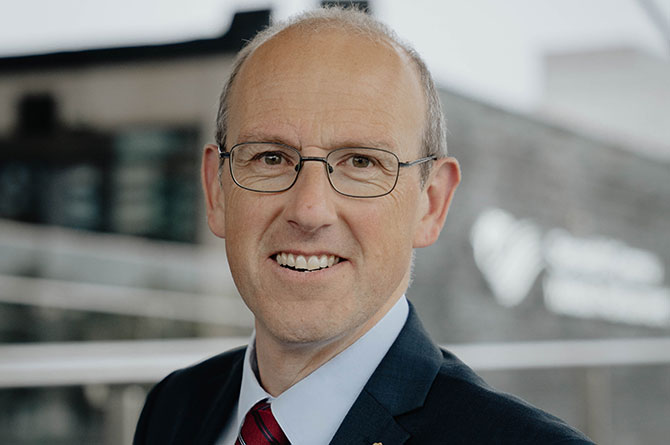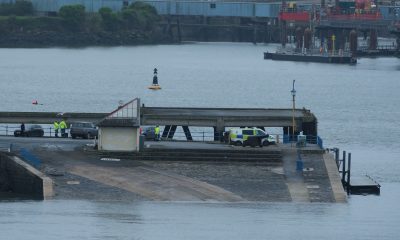Education
Walk to school and win

Walking to school: Getting children active
THE CHARITY Living Streets Cymru is calling for local authorities to prioritise making school walking routes safer, to help to prevent problems associated with a lack of walking, including child obesity and air pollution.
Research carried out by Living Streets shows that almost 60 per cent of parents are worried about speeding cars outside of school and a third are worried about their child’s safety because of overcrowding outside of the school gates.
A huge 82% of parents think there should be more schemes to make the walk to school safer and easier.
This comes at a time when one in three children leave primary school overweight or obese, and just one in five children achieves the recommended daily amount of physical activity.
Following a generation-long decline in the number of children walking to primary school (from 70% to 47%), and the recent publication of the historic Wales Active Travel Act, Living Streets is now urging local authorities to act and encourage more families to walk to school.
Rachel Maycock, Wales Manager, Living Streets says: “The walk to school is a great way of children getting active in the morning before school. It’s easy, free, accessible and a great way for children to get some regular exercise.
“It’s essential that local authorities make all our streets, including those around schools, safe places to walk, through installing 20mph speed limits and safe crossings.
“We know that a lot of parents are put off walking to school because of high levels of traffic outside the school gates. The more of us walking to school, the safer conditions will be.”
May is National Walking Month, Rate Your Walk during May 2017 and you will be in with a chance of winning a UK city break for you and your family.
The charity is urging members of the public to rate their walk to school via www.livingstreets.org. uk/rateyourwalk
Education
Target of 1m Welsh speakers by 2050 is “almost impossible”

A TARGET to reach a million Welsh speakers by 2050 is “almost impossible” to hit due to real-terms budget cuts, with demand for courses outstripping capacity, a committee heard.
Dona Lewis, chief executive of the National Centre for Learning Welsh, gave evidence to the Senedd’s culture committee as part of a one-day inquiry into post-16 Welsh provision.
Ms Lewis warned that the “massive” growth the National Centre for Learning Welsh had hoped to achieve this year will no longer be possible.
She told the committee there are waiting lists for people who want to learn Welsh, “so the demand is higher than what we can reach at the moment”.
Ms Lewis said: “Our work has grown since the centre was established back in 2016 and funding has grown with that. But, to reach more people, clearly, more funding is needed.”
Llyr Gruffydd warned that budget pressures jeopardise the chances of meeting the target of a million Welsh speakers and doubling daily use of the language by 2050.
The Plaid Cymru MS for North Wales said: “Reaching the targets of Cymraeg 2050 was challenging already and almost impossible now.”
Mr Gruffydd suggested it is a tragedy that the National Centre for Learning Welsh cannot meet demand, saying: “There’s a risk that we’re missing out on an historic opportunity.”
The Welsh Government’s 2024-25 budget allocates £53.5m to support Welsh language spending, with a near-£3m reduction compared to last year, according to a report.
Ioan Matthews, chief executive of Coleg Cymraeg Cenedlaethol, which works with colleges, universities and employers, said further education and apprenticeships are crucial.
Dr Matthews told the committee that opportunities to study through the medium of Welsh have been few and far between until relatively recently.
Dafydd Evans, representing Colleges Wales, welcomed a more positive approach since Coleg Cymraeg Cenedlaethol’s remit was widened to include further education.
Pressed about whether the Cymraeg 2050 targets are realistic, Mr Evans, who is chief executive of Gr?p Llandrillo Menai, was not confident the aims are achievable.
Mr Evans, who has worked in the sector for 30 years, said: “If we’re going to have new Welsh speakers then we would need a lot more resources in the pot to reach that target.”
Carolyn Thomas, a Labour backbencher, highlighted the Welsh language commissioner’s warning that attempts to expand post-compulsory provision have been an uphill battle.
Dr Matthews said there has traditionally been a lack of investment but the picture is changing and he was hopeful funding will be restored next year.
Asked about the impact of the re-prioritisation of the Welsh Government’s budget, he told MSs that there is a risk of losing momentum and opportunities as a result.
Dr Matthews agreed that budget pressures will make the 2050 target more challenging.
He said: “What we need is a plan and trajectory which sets out milestones for us. But any slowing down of that momentum will make that trajectory more challenging.”
Mr Evans stressed the importance of focusing on transitions from education and promoting the value of Welsh in the workplace, so young people see the language as a skill.
Lisa Mytton, strategic director of National Training Federation Wales, raised concerns around recruiting qualified assessors and cuts to the apprenticeship budget.
Mr Evans called for a national strategy to create a bilingual teaching workforce, saying there is a “massive problem” in recruiting Welsh speakers in fields such as science.
He welcomed a review of vocational qualifications, carried out by Sharron Lusher, the former principal of Pembrokeshire College, but warned that progress on its findings has been slow.
Mr Evans said made-in-Wales qualifications and resources are currently not in place.
Dr Matthews pointed to the potential role of the forthcoming Welsh language education bill, which aims to transform provision in schools and give learners more meaningful skills.
Education
Senedd shoots down outdoor education bill

MEMBERS of the Senedd rejected calls to establish a legal requirement for residential outdoor education opportunities for children and young people in Wales’ schools.
The Senedd narrowly voted against the general principles of the residential outdoor education bill, which was introduced by the Conservatives’ Sam Rowlands.
Mr Rowlands said his bill would remove a postcode lottery in terms of access to residential outdoor education, so no child misses out due to their personal circumstances.
He explained that the bill would create an entitlement for all pupils in maintained schools to experience at least four nights of residential outdoor education free of charge.
The North Wales MS argued the bill would have a long-term net positive economic impact.
He warned: “Outdoor education residentials are valued by children, parents and teachers alike, yet, for those without the means to access them, they are, in fact, unattainable.
“I believe this is fundamentally wrong and this bill sets out to remove those financial barriers to participating in what can be life-changing experiences.”
Mr Rowlands, a former Conwy council leader, said the bill would support the long-term physical and mental health of young people.
Labour’s Buffy Williams outlined the education committee’s stage-one report on the bill, which raised concerns about some children and young people being excluded.
The newly elected committee chair pointed to the example of education other than at school, such as pupil referral units or those who are homeschooled.
Peredur Owen Griffiths, who chairs the finance committee, said the bill would require significant funding against a backdrop of Welsh Government budgetary pressures.
An impact assessment found the bill would cost between £74m and £96m over five years.
Sarah Murphy, the Labour MS for Bridgend, raised the legislation committee’s concerns about the lack of a definition of residential outdoor education in the bill.
Ms Murphy, who was elected chair in a knife-edge 28-29 vote on Tuesday, warned that the bill does not provide an appropriate mechanism for pupils to opt out.
Peter Fox said Monmouthshire council prioritised access to outdoor education while neighbouring councils withdrew support to make efficiency savings.
The former council leader said: “We rationalised our provision and maintained the offer, as we had seen the benefits of children for decades.”
Mr Fox told the chamber it is a sad indictment that the Senedd does not enable backbench legislation to progress, with no opposition bills agreed since 2016.
The Monmouth MS said: “Why don’t we allow these things to progress and see where they go? And if you can’t find a way through that, then things can be stopped in the future.
“Why always stop legislation before it has an opportunity to progress, to breathe and to really show what it has the potential to do?”
Heledd Fychan, Plaid Cymru’s shadow education secretary, backed the bill’s core aim of ensuring equal opportunity for every child.
However, she highlighted the huge pressures already on school staff who often volunteer to help with residential outdoor education.
“They don’t receive any additional payment for this work,” she said. “They do it because they see the benefit for the children and young people in their care when they are in our schools.”
Carolyn Thomas, the Labour MS for North Wales, raised existing school budget pressures, with the bill estimated to cost about £20m a year to cover teachers, lodging and transport.
She said: “At a time when schools are having to face extremely difficult decisions, including redundancies, placing additional pressure on the education budget would be unthinkable.”
Lynne Neagle raised concerns about the capacity of the outdoor education sector to meet the bill’s requirements on the Welsh language and additional learning needs provision.
Wales’ new education secretary warned the bill would require additional changes to terms and conditions of school staff, which could hamper recruitment and retention.
Ms Neagle said education unions and councils have significant concerns about the potential impact on an already stretched financial situation facing schools.
She told the chamber the bill would bind the Welsh Government to expressly fund residential outdoor education over and above any other aspect of Wales’ new curriculum.
The Senedd voted 25-26 against the bill following the debate on April 17, with opposition members outnumbered by the Welsh Government and Labour backbenchers.
Education
Pupils take centre stage for dance competitions

MORE than 230 Pembrokeshire pupils have taken part in exciting dance competitions at primary and secondary school levels.
Sport Pembrokeshire hosted the primary school dance competition on March 19th at Fishguard Leisure Centre.
Seven schools from across the county and more than 160 pupils took part, including both boys and girls from school years 3-6.
All style and street dance were the categories that teams, solos and duos could enter. There were 55 solo performers entering the street dance solo category.
Pupils from Ysgol Bro Gwaun performed a group dance and some performed brilliant solos for the primary pupils to watch.
Finola (FF Dancers), Kelly (Kelly Williams School of Dance) and Lowri (Lowri Jones School of Dance) judged the high standard of competitions with dance coaches Lucy Kerrison and Kelci Francis helping out during the day.
They are all thanked for their help and expertise as putting on an event of this nature would not be possible without their valuable input.
Forty eight medals, 22 trophies and numerous certificates were presented, including awards for stand-out performers.
The atmosphere was great and it was brilliant to see the pupils taking part, getting creative and showcasing their skills, all with a smile on their faces.
The secondary schools dance competition was hosted on Thursday, 29th February at Haverfordwest Leisure Centre.
In total 77 girls from school years 7-11 competed in various categories such as teams, duos and solos. These included street, all style, freestyle, jazz and cheer.
Finola and Kelly judged the day with the help from Lucy and Kelci. Kelci, a former Ysgol Harri Tudur pupil, also gave showstopping performances.
It was a great day with a fantastic atmosphere and very rewarding to see so many girls taking part in sport and enjoying every minute.
Some of the schools who attended are now through to the UDOIT Dance Competition in Cardiff.
Hundreds of pupils have enjoyed school dance competitions over recent weeks.
-

 News7 days ago
News7 days agoSearch for missing teenager Luke continues at Pembroke Dock
-

 News5 days ago
News5 days agoPolice issue update on the search for Luke, missing from Pembroke Dock
-

 News7 days ago
News7 days agoPembrokeshire hostel manager narrowly avoids jail sentence
-

 Sport6 days ago
Sport6 days agoHerbrandston Clinch Promotion to Division One
-

 News4 days ago
News4 days ago20mph U-turn: Some roads will return to 30mph following public outcry
-

 Community4 days ago
Community4 days agoMiracle pup finds her forever home after heart-wrenching journey
-

 Crime7 days ago
Crime7 days agoPembrokeshire car salesman caught driving on cocaine
-

 News7 days ago
News7 days agoMicky Beckett, Pembrokeshire’s Olympic hopeful, wins big in Palma!

























